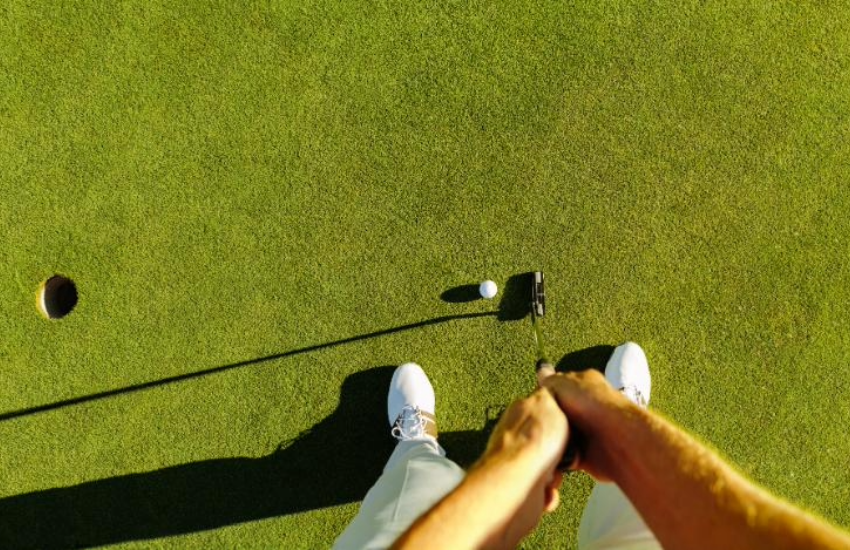
Putting is often called the “game within the game,” and for good reason. It’s the smallest swing you’ll take on the course, yet it carries the most weight. A misread break or misjudged speed can turn a sure par into a double bogey or worse.
Even seasoned golfers aren’t immune to the struggles of putting. So, if you’re still battling the dreaded three-putt, trust us, you’re not alone. That’s why we’ve put together the ultimate golf putting guide, packed with putting tips to sharpen your skills and lower your score.
Why Practicing Golf Putting Matters
Throughout a typical golf round, nearly half of your strokes will be putts. From long lag putts to pressure-packed three-footers, your ability to navigate the greens efficiently can shave strokes off your game faster than making improvements in your full swing. Even the most consistent ball-strikers can struggle to score well without a solid putting game, proving that it’s not just about how far you hit the ball.
6 Tips to Improve Your Golf Putting

1. Read the Green (and the Grain)
Accurately reading greens can transform your golf putting game. Start by analyzing the slope and note whether the terrain tilts left, right, uphill, or downhill. Next, pay close attention to the grain of the grass. The grain affects the speed and direction of your putt, often following the sun or the direction the grass grows. A shiny surface typically means the grain is running away from you, making the putt faster, while a darker, duller appearance indicates the grain is into you, slowing things down.
Take a step back and look at the entire green from different angles, especially from behind the ball and the hole. These perspectives help you spot subtle breaks that might otherwise go unnoticed. Finally, visualize the ideal path of the ball as it rolls toward the cup. A good read doesn’t guarantee the ball will drop, but it lays the groundwork for a confident stroke and a better chance at success.
2. Perfect Your Setup
A consistent setup is the foundation of reliable putting. Focus on your posture, grip, and alignment every time you address the ball. Keep your eyes directly over the ball, your putter face square to the target, and your hands steady to promote a smooth stroke. A repeatable setup builds confidence and eliminates unnecessary variables from your putting routine. Consider using alignment sticks as a training aid to perfect your setup.
3. Pace Over Power
Speed control is often the unsung hero of great putting. While aim is important, the right pace ensures the ball has a chance to drop, or at least leaves you with an easy tap-in. Practice lag putting to sharpen your distance control, especially on longer putts, where speed is everything. Remember, avoiding a three-putt is often as valuable as sinking a long one.
4. Find Your Rhythm
Putting isn’t just about mechanics; it’s about feel and rhythm. Develop a smooth, repeatable stroke that you can rely on, even under the pressure of a make-or-break putt. A consistent tempo not only steadies your nerves but also helps you stay in sync with the greens’ speed and conditions. Think ‘tick-tock’ during your backstroke and follow through to help maintain your rhythm.
5. Practice with Purpose
Every great putter practices with intention. Use drills like the “gate drill” to improve accuracy and the “ladder drill” to fine-tune your distance control. Incorporate challenges that simulate real-game pressure to build confidence. With focused, deliberate practice, you can turn putting from a weakness into a weapon.
6. The Mental Challenge
Putting is a mental challenge, too. That’s why it’s important to develop a pre-putt routine that calms your mind and builds confidence. Visualization is key; picture the ball rolling along the line you’ve chosen and dropping into the cup. Staying positive, even after a missed putt, can help you approach the next one with a clear head.
3 Common Golf Putting Mistakes
Even experienced golfers fall victim to common putting pitfalls, and these small mistakes can add strokes to your score in no time. Here are a few to watch out for, and how to correct them:
1. Lifting Your Head Too Soon
This is one of the most common golf putting errors, often caused by impatience or eagerness to see the result of your stroke. Following the ball with your head too early can pull your putter offline and ruin your alignment. Instead, focus on staying still and disciplined through the stroke. Keep your head down, your eyes fixed on the ball, and only look up after you’ve made contact. A good trick? Listen for the sound of the ball dropping into the cup – it’s as satisfying as seeing it go in.
2. Swinging with Your Wrists
A reliable putting stroke hinges on a steady pendulum motion driven by your shoulders. Using your wrists introduces inconsistency and makes it difficult to control speed and direction. To fix this, imagine your arms and putter forming a “Y” shape that stays intact throughout the stroke. Practice keeping your wrists quiet and letting your shoulders do the work. Drills like the “towel drill,” where you hold a towel under your arms as you putt, can help reinforce this smooth, shoulder-driven motion.
3. Decelerating
A hesitant or decelerating stroke leads to putts coming up short or veering off line. This often happens when golfers second-guess themselves mid-stroke. To maintain a consistent pace, focus on accelerating through the ball with a smooth follow-through. Drills like the “one-handed putting drill” help you build confidence in your stroke and ensure you avoid this common golf putting mistake.
Choosing the Right Putter
Choosing the right putter involves understanding the specific features that complement your stroke style and preferences.
- Head Style: The shape of the putter head can influence alignment and stability. Mallet putters, with their larger and more forgiving design, offer better alignment aids and balance, making them ideal for golfers with a straight-back, straight-through stroke. Blade putters, on the other hand, are lightweight and sleek, better suited for players with an arc-shaped stroke.
- Length: The right putter length ensures your eyes are positioned directly over the ball and allows for a comfortable setup. Standard lengths range between 33 to 35 inches, but testing different options to match your posture and arm positioning is crucial. An ill-fitting putter can throw off your aim and alignment.
- Grip Style: A thicker grip can help reduce wrist action, creating a more pendulum-like motion driven by your shoulders. Thinner grips offer more tactile feedback but may lead to overactive wrists for some golfers. Find a grip that balances feel with control.
- Face Insert: Consider whether you prefer a traditional milled face or a putter with a softer insert. Milled faces provide more feedback and a firmer feel, while inserts tend to offer a softer feel and better energy transfer on slower greens.
- Weight and Balance: The weight distribution and balance of a putter can significantly affect your stroke’s tempo and consistency. Heavier putters can smooth out your stroke, while lighter putters might offer more control for players with a faster tempo. Counterbalanced putters, with added weight in the grip, can enhance stability.
Why Custom Fitting Matters
Off-the-rack putters can work, but a custom-fitted putter is often a game-changer. Fitting sessions analyze your stroke, alignment tendencies, and grip preferences to identify the ideal combination of length, loft, lie angle, and head design for your game. The result? A putter tailored to your natural motion, boosting both confidence and performance.
Remember, golf putting accounts for nearly half of your strokes in a round, so investing in the right equipment is worth it. A properly fitted putter can help you start each stroke with confidence, knowing your gear is perfectly suited to your game.
By focusing on proper technique, avoiding common pitfalls, and understanding the nuances of your equipment, you can transform the greens from a source of frustration to an area of opportunity.
Remember, even the pros struggle with golf putting from time to time. It’s part of the game. The key is to practice with purpose, trust your instincts, and approach each putt with confidence. Whether you’re sinking a clutch three-footer or navigating a tricky lag putt, the golf putting tips in this guide will help you refine your skills and lower your scores.
So the next time you step onto the green, be prepared to read it, feel it, and trust it. With time and dedication, you’ll turn your putter into one of the most reliable clubs in your bag, and maybe even your secret weapon.